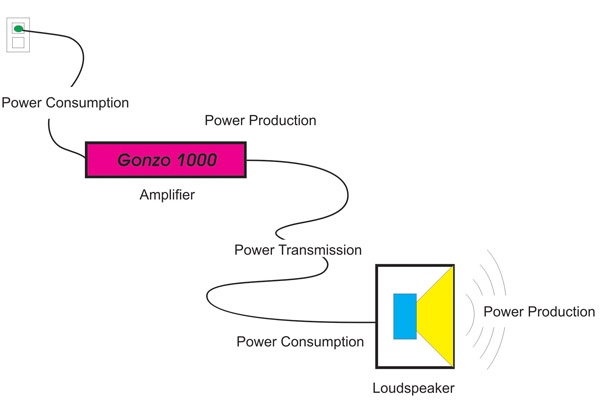
The loudspeaker must be considered on this basis. Don’t just tell me what it uses, tell me what it produces!
Shopping for loudspeakers by looking for the one with the highest power rating might be like shopping for cars using only the miles-per-gallon rating, and then picking the one that gets the worst mileage!
We all know experientially that if we move something from point A to point B there is always a force present that will object to the movement and oppose it.
In a mechanical system, one such force is friction. Friction converts some of the applied power into heat (another form of energy). The analogous parameter in an electrical circuit is resistance. Resistance opposes the flow of current through a component or conductor, and dissipates some of the applied power in the form of heat.
Power is paid for by the kilowatt-hour, and the prudent owner or renter tries to get as much benefit as possible out of the least amount of consumption.

Resistance forms a load on the power source—something which it must overcome. Reducing the resistance causes more power to flow due to the lower opposition, and we say that the power source is under a greater load. This is why two loudspeakers in parallel cause an amplifier to produce more overall power than it would into a single loudspeaker (but usually less power per loudspeaker).
A bucket with two holes in it loses its water twice as fast as a bucket with single hole in it. There is less resistance to the water leaving the bucket, and hence more flow.
Power consumption is all about heat. If there is no heat, there is no power consumption. The factor that determines a loudspeaker’s power rating is its ability to dissipate heat. An overpowered loudspeaker is one that is getting too hot.
Note that there are other ways to devour loudspeakers besides toasting them (over-excursion for example), but these are not necessarily power issues.
The Light Bulb Deception
One reason for the confusion surrounding power in audio systems can be attributed to the light bulb. Light bulbs are rated in watts, and we all draw a correlation between the wattage rating and the brightness. This produces a “more power, more light” mentality, which many intuitively apply to sound.
But if you read the package closely, the real parameter of interest regarding the light generating properties of a light bulb is its luminosity—the lumens generated by the applied power. The power rating indicates how much power is dissipated in the process of generating the rated number of lumens.
Both numbers must be considered to evaluate the bulb’s performance. If I can get more lumens and consume less power, I have a better bulb—assuming that I have not compromised some other key parameter, such as longevity.
Like the light bulb, a loudspeaker has a wattage rating that indicates how much power it consumes continuously as it does its job (its job being to produce “X” amount of sound). But the real parameter of interest is the amount of sound power that results from the consumed electrical power. In fact, most of the applied power gets converted into heat rather than sound.
The sound power, like the electrical power, is rated in watts. A perfectly efficient loudspeaker would convert all of the applied electrical power into sound, with no resultant heat, so one watt of electrical power would yield one watt of acoustic power.
In reality, the conversion rate is much lower, typically less than 25 percent for compression drivers and less than 10 percent for cone loudspeakers (ironically similar to the light bulb’s efficiency, with similar heat production!). It’s a good thing that we can’t touch those voice coils during use.
The ratio between the applied electrical power and the radiated sound power is the loudspeaker’s efficiency, which indicates the percentage of electrical power that is converted into sound power.
